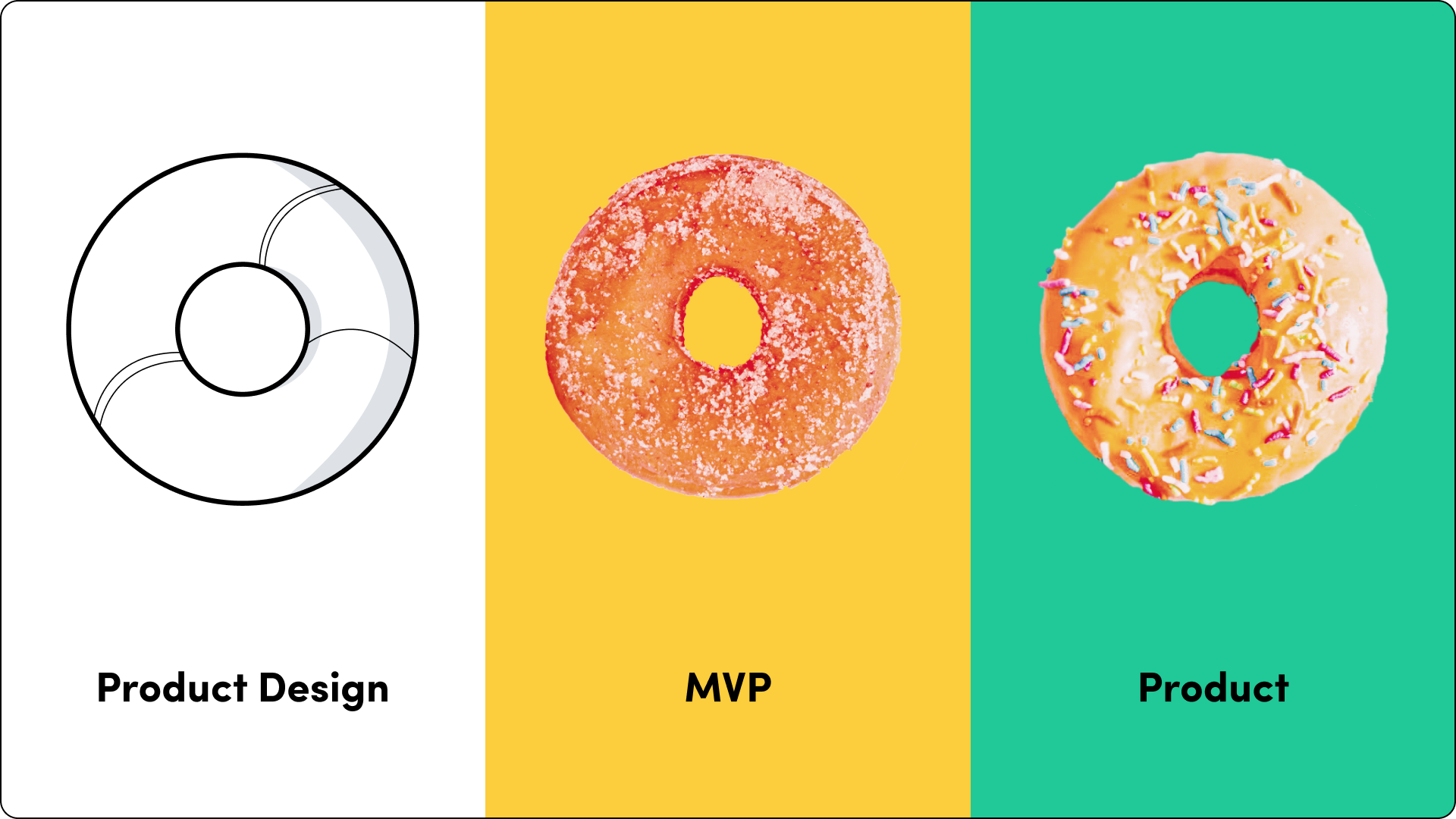

You have released a minimum viable product (MVP) to the market – it’s up and running. Now you’re probably wondering what’s next in the startup lifecycle after the MVP stage. Luckily, you’re not the only one. There are tons of articles and posts asking the exact thing: “I have my MVP, now what? What should be the next step for my startup?”. And today, you’ll know the answer.
In the previous articles, we talked about ways to validate your idea and the software development lifecycle. We also covered a minimum viable product development process – what is an MVP concept, how it can benefit businesses at the start and many more.
If you want to learn solely about the MVP stage, read Minimum Viable Product – What is an MVP?
In today’s blog post, I’ll cover:
- why is MVP important,
- startup growth phases,
- 3 reasons why startups fail,
- how to go from minimum viable product to minimum marketable product (MMP),
- how to scale up a startup.
Why developing the Minimum Viable Product?

What can you get when you start your business from an MVP development? When done right, a minimum viable product can help you prevent your startup failure. First of all, you get to test the business hypothesis, the product idea at a lower cost than a complete product.
It’s a product that brings immediate value
Because an MVP is an early version of a product with only the minimum feature set, it can represent the idea of a finished digital product (functionalities like easy-to-navigate user interface are still there). Thanks to this, the potential target users can tell you whether or not they’re likely to buy it. Hence, it shows you the market demand.
Plus, it’s an iterative process – you get user feedback from the product’s initial users on what’s missing, what can be improved, and for the new ideas for features (which is one of the future benefits).
It’s a product that puts users on the first place
The MVP approach is also about validated learning. So once you collect feedback, you get to really understand what the market needs and improve an MVP even further during development phase. This, in turn, increases the chances of succeeding in a market since you can determine business objectives and pain points.
What else? When building a basic version of a product, you save time, resources and bring immediate value to potential buyers. As a result, the team doesn’t have to focus on all the features, so the money can be spent on actions to help the product launch. For example, to make the marketing efforts more effective.


Have a project in mind?
Let’s meet - book a free consultation and we’ll get back to you within 24 hrs.
Startup stages of growth
Identify a market need
It’s the very beginning of the process when you see that need for something in the market. There’s a problem, and you got an idea of HOW to fix it. When you do the initial market research, check if a similar product is already available on the market.
See the market feedback – the truth is that not everyone wants your product. Select your users, provide focused group tests and collect customer feedback. In this way, you should be able to know if there’s a marketplace for your product.
Validate the idea
During this stage, you probably start working with the software development company. A great team will provide you with technical support and, at the same time, help you with determining the product’s core, prioritizing features, creating a product roadmap, along with competitor’s analysis and user journey.
Start with proof of concept (PoC) if the product is innovative. Other than that, you get the prototype and then turn it into an MVP, which eventually becomes the final product.
Scale up – develop a minimum marketable product
Or, in other words, grow your business. The trick is to develop the product in the right direction. So, from minimum viable product, you go to minimum marketable product. Which is exactly what we’ll be talking about later.
3 reasons why startups fail
According to Embroker, 90% of startups fail. What’s more, the rate is more or less the same no matter the industry. Is it the wrong business model? Insufficient value proposition? What’s the reason?
- There’s no focus on users
One of the leading causes of startup failure is misreading market expectations. Not fulfilling the needs is a strike one. This focus relates to the business’ core and, more importantly, the target audience. Because in the end, it’s all about the customer demand. So here, minimum viable products can fix that. Their needs, problems, requirements – all of these factors should shape your digital products and your approach to it. There’s no way around it. Real users are your most valuable source, so use it during user tests – listen carefully, collect early adopters’ feedback and implement it to satisfy early adopters.
Learn more about the usability tests from our article. - It’s all the same
Nowadays, it’s a world full of competition – every business struggles with it. When you operate and promote your product the same way your competitors do, how do you expect to win over the customers? Stand out from the crowd, collect product ideas and don’t hesitate to iterate. Find something unique about your brand, use it and mark your way to the final product. - Wrong people on board
Everybody’s going to tell you that you have slight chances for success without connections and team. But with them? You’re one step ahead. So, once you have an idea, start connecting with people. Go to the events, make friends, and use these connections to create your dream product when the time comes.
As for the tech team – this is one of your most important choices. There are many companies available but remember – the right software development team will support you on every step of the way. Not only in technical aspects but in business too, so choose wisely.
And if you still haven’t found the right company, check out our previous article about 3 steps to choosing a software development company.


Have a project in mind?
Let’s meet - book a free consultation and we’ll get back to you within 24 hrs.
Post MVP – it’s time to build the minimum marketable product (MMP)
Let’s gather everything we’ve been talking about throughout this article. The minimum valuable product goal is to validate the product hypothesis, whereas the minimum marketable product is to release the product to the audience and get the first proof of success. It’s the logical continuation – MMP is the first version of the product with features users expect, bringing valuable feedback back to business.
Moreover, this approach allows for faster profit maximization as well as faster production augmentation of profit. One of the most important minimum marketable feature is delivering the right solution to the customer’s problem. All in all, a minimum marketable release lets you concentrate on a limited number of functions rather than creating a hidden tool over a longer period of time.
So how to go from MVP to MMP during the development process?
Use customer feedback & data collection
Quantitative analytics and research provide you with the user feedback that the team can use to build an excellent scaling strategy. Thanks to the input, they can also determine which new features should be developed first, make alterations to the product and test it again. Such an approach will ensure that your product will succeed on the market in the long run and that it’ll continually develop but with needed flexibility.
How to measure the MVP performance?
Focus on the core strategy & business idea
The post-MVP development is all about scaling. With a growing user base and new needs and problems, you need to scale up the digital product. Only in this way, you’ll be able to meet their needs with extra features and acquire new customers.
But the scale up process isn’t a piece of cake. You have to alternate not only a product but a whole business as well – to learn to look at it as a whole. To do that successfully, you need to focus on the core strategy and, with that product vision, develop the proper process and have the right tech team by your side.
Plan ahead of the first version
Building the right scale up strategy is also a part of planning. Thus, plan everything you can using all the available resources such as real user feedback, metrics, team’s expertise. Together outline a plan for each stage of growth.
Take care of financial liquidity
When thinking about the process, you should also consider all the costs connected to it. Many startups fail when it comes to post-MVP scaling. It’s all about scaling up product and delivery services to meet the gaining needs of an increasing customer base.
Hence, as part of the process, you should develop an operating structure and the company’s internal hierarchy. The right workflow is also an essential factor in the scaling process. As you grow your business, you need individual team sizes for all four tier operations and financial activities. This provides an infrastructure that has room for growth. Remember the money spent as well as unexpected costs to manage all the support staff and scalable cloud services. These include CRM, a virtual customer support centre and payment APIs.
You’re not doing scale up just for the sake of it, but rather to cater to the user’s needs and provide them with a product that they’ll use and recommend it. So don’t stop at the initial success. Go further.
Don’t dismiss marketing strategy
But instead, invest in it. And soon enough, you’ll see that the investment will pay off. Again, thanks to analytics tools and performance metrics, you’ll know how much money you have to spend to get the customer.
Test & analyze
The startup strategy should be about flexibility and testing to constantly improve the product’s quality. Hence, processes such as quality control, quality assurance and testing should be present in the process.
Want to know more about quality assurance? Read our previous article on how to take care of software quality.
Final words
Post-MVP development isn’t the easiest one. From the first launch of the product until product-market fit – it’s a long way. Hence, during development of the right growth strategy, make sure you have the financial liquidity for more, and most importantly, you have the right team on your side is key to a minimum marketable product release. But once you embark on the MVP journey with a plan and a great software development team, it certainly will be less difficult to scale up the product that the customers love.
Want to develop an MVP but don’t know where to start? Reach out to us! Let’s start this journey together.


Have a project in mind?
Let’s meet - book a free consultation and we’ll get back to you within 24 hrs.
Ela writes about the fundamentals of great development, project management approaches, ways to develop a proof of concept or an MVP, UX, our company culture, and many other things happening in Gorrion.




